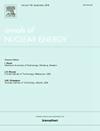Numerical modeling of alkali metal heat pipes
Abstract
Heat pipe cooled reactors passively transfer heat from the core to the energy conversion system through alkali metal heat pipes. Further studies of the heat transfer characteristics of alkali metal heat pipes are needed to develop heat pipe cooled reactors. This work used a two-dimensional heat and mass transfer model of an alkali metal heat pipe. The flow field was validated against CFD predictions which showed that the model has less than 10 % errors in the velocity distribution and less than 5 % errors in the pressure distribution. A comparison of the predictions with experimental data in the literature indicated that the predicted wall temperature error was within 30 °C. This model was then used to analyze four factors that affect heat transfer in sodium heat pipes. The simulations show that higher heat fluxes shorten the startup time by approximately 70 % but significantly increase the operating temperature. The heat flux distribution significantly affects the evaporator temperature distribution. The heat transfer boundary condition on the condenser’s outer surface mainly affects the operating temperature and startup time. Increasing the heat pipe length-to-diameter ratio with a fixed heat flux increases the operating temperature with the increase proportional to the heat flux. This model provides accurate simulations of sodium heat pipes for various heat transfer boundary conditions. The simulations provide a reference for the selection of working conditions for heat pipe operation instability experiments.

 求助内容:
求助内容: 应助结果提醒方式:
应助结果提醒方式:


